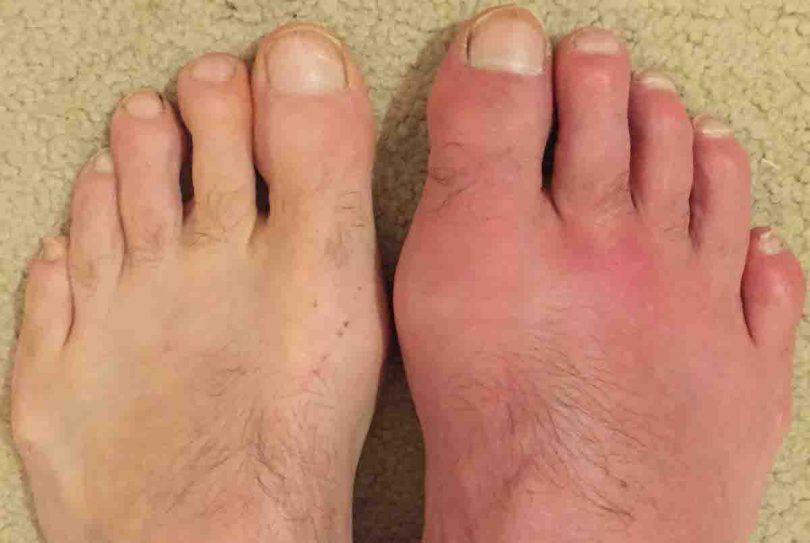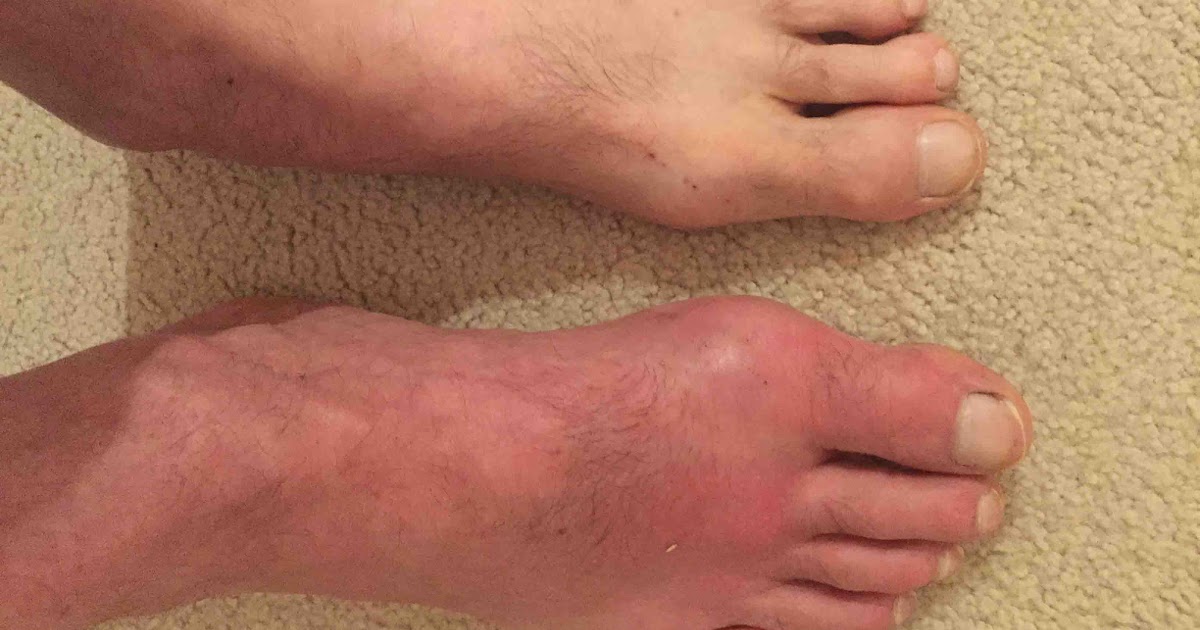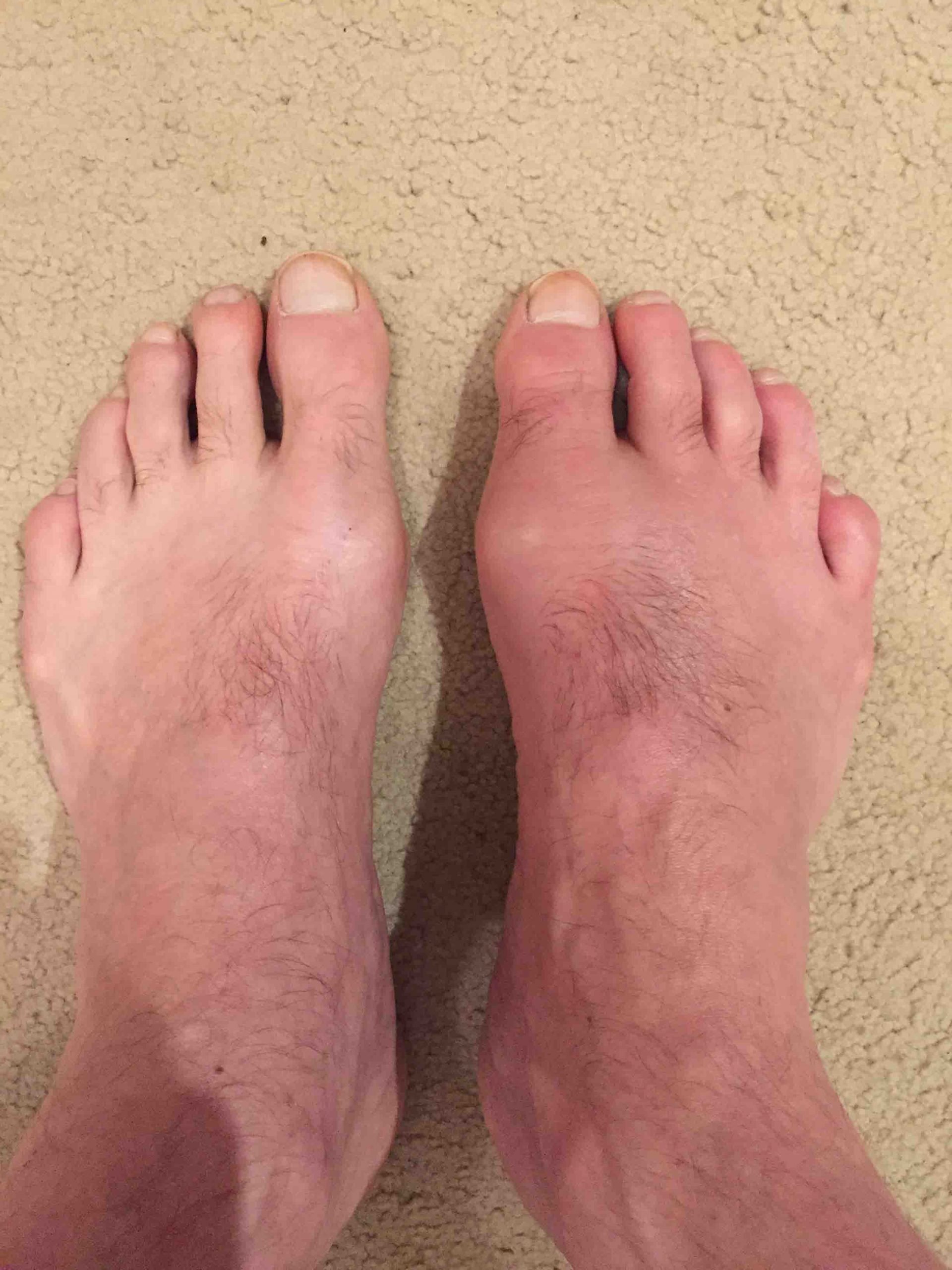Treating Gout With Medications
Certain medications reduce the pain and inflammation of gout attacks, such as anti-inflammatory drugs , colchicine, and corticosteroids. Other medications decrease the level of uric acid in the blood and prevent the deposit of uric acid in joints , the kidneys , and in tissue , helping to prevent further attacks and complications. These drugs include allopurinol, febuxostat, lesinurad, and probenicid.
Can It Lead To Any Complications
If left unmanaged, gout-related inflammation can cause permanent damage to your ankle joint, especially if you have frequent flare-ups.
Over time, lumps of uric acid crystals, called tophi, can also form around your ankle. These lumps arent painful, but they can cause additional swelling and tenderness during a flare-up.
Gout In Foot: Causes And Risk Factors
In about 90 percent of hyperuricaemia cases, there is impaired renal excretion in about 10 percent, there is a problem with overproduction.
- Urate overproduction can be linked to lifestyle factors and certain diseases such as bone marrow cancers, psoriasis, and hemolytic anemia. Lifestyle factors include being overweight and ingesting excess amount of fructose or alcohol.
- Renal impairment has multiple causes, including gene mutations, hypertension, diuretic drugs, lead exposure, and cyclosporine immunosuppressive therapy.
- Gender and age. Men are twice as likely to develop gout as women. In men, the risk rises with age. Gout is uncommon in younger women but the incidence increases dramatically after menopause, due to falling estrogen.
- Western diet. There is solid evidence from the Health Professional Follow-up Study of a link between gout and purine-rich foods. See gout diet.
- Medications. Diuretics, antihypertensives, niacin, aspirin, chemotherapy and immunosuppressive drugs increase the risk of gout.
- Other conditions. Certain conditions carry an increased risk of gout including: Recent joint injury or surgery, cardiovascular disease, chronic pulmonary disease, anemia, psoriasis, renal disease, blood cancers, and metabolic syndrome.
Read Also: Almonds Good For Gout
The Pathology Of Gout
Gout is primarily a metabolic disorder in which uric acid accumulates in blood and tissues. When tissue levels reach saturation, needle-like crystals form, causing inflammation. This occurs most commonly in the cooler joints, notably the metatarsophalangeal joint of the big toe.
Many people with hyperuricemia never develop gout, but those with the highest levels are most likely to suffer episodes. Hyperuricemia may also lead to kidney stones.
Decreased Excretion Of Uric Acid

Two thirds of urate excretion occurs in the kidneys while the rest is excreted through the gastrointestinal tract . Reduced secretory function of the transporter ABCG2 leads to decreased excretion of uric acid through the GIT resulting in rise of serum levels of uric acid and enhanced renal excretion .
You May Like: Almond And Gout
Change Your Shoes Or Put On Some Padding
When it comes to bone spur symptoms, changing your footwear might help, especially if you spend a lot of time on your feet.
In order to avoid pain and fatigue, choose shoes that dont squeeze your toes or are too loose.
If you want to add a little additional room, wear shoes with rounded or square toes. If you have a low arch, you might consider adding extra padding to your shoes to alleviate the strain.
How Can I Manage My Gout And Improve My Quality Of Life
Gout affects many aspects of daily living, including work and leisure activities. Fortunately, there are many low-cost self-management strategies that are proven to improve the quality of life of people with gout.
For gout in particular:
- Eat a healthy diet. Avoid foods that may trigger a gout flare, including foods high in purines , and limit alcohol intake .
CDCs Arthritis Program recommends five self-management strategies for managing arthritis and its symptoms. These can help with gout as well.
Read Also: Black Cherry Juice For Gout Cvs
The First Twinge Of Stiffness Or Dull Ache
Gout ankle starts with a twinge of pain or a dull ache. Then along with the pain, stiffness starts to set in these are the first signs of gout and the alarm to take action. These gout symptoms in the ankle will only quickly get worse if left unattended.
The reason that an attack grows slowly, is because more and more uric acid continues to crystallize. Taking measures to alkalize neutralize the acidity helps to dissolve the crystals that have already formed, but more importantly, helps to keep the uric acid in solution and keep it from crystallizing in the first place.
Uric Acid Is The Cause
When there is an overabundance of uric acid in the blood it is called gout. Usually, having too much uric acid in the blood is not harmful. In fact many people with high levels in their blood never know about it. When uric acid levels in the blood become extremely high, the uric acid may start to form crystals. These crystals most commonly form in the joints, especially the joints in the big toe. Your odds of experiencing the pain of gout are higher if you are overweight, drink excessive amounts of alcohol, or have a diet that is comprised of meat and fish that are high in chemicals called purines.
Also Check: Are Almonds Bad For Gout
What Part Of The Foot Does Gout Affect
The medical condition that is referred to as gout is a painful ailment that affects the feet. More specifically, the joints in the big toe are typically distressed if this form of arthritis develops. It can cause severe pain and discomfort and may lead to joint deformities if it is not treated early. It occurs as a result of excess uric acid that exists in the blood levels. This may produce crystals that lodge in the joints of the big toe. This condition is typically caused by eating foods that are high in purine levels. These often include red meat, shellfish, and alcohol. There are methods that can be implemented, which may prevent gout attacks from occurring. These can consist of losing weight, performing a daily exercise routine, and eating healthy foods. If you are having pain in the big toe and surrounding areas and would like additional information about how gout affects the feet, please consult with a podiatrist.
Gout is a foot condition that requires certain treatment and care. If you are seeking treatment, contact Dr. Thomas Madden from Advanced Foot Care Center. Our doctor will treat your foot and ankle needs.
What Is Gout?
Gout is a type of arthritis caused by a buildup of uric acid in the bloodstream. It often develops in the foot, especially the big toe area, although it can manifest in other parts of the body as well. Gout can make walking and standing very painful and is especially common in diabetics and the obese.
Symptoms Of Extensor Tendinopathy
The symptoms of extensor tendinopathy tend to be confined to the top of the foot, occasionally spreading to the arch of the foot:
- Top of Foot Pain:Tends to be worse with activity and better with rest. The top of the foot maybe tender to touch making it uncomfortable wearing shoes
- Swelling:There may be some visible swelling and/or bruising across the top of the foot
- Bruising: You may notice some mild bruising across the top of your foot
A simple test for extensor tendinopathy is to try and draw your toes up towards you while resisting the movement with your hand. If that recreates your pain on top of foot, you probably have the condition.
Also Check: Almond Good For Gout
Is There A Connection Between Gout And Turf Toe
If you are predisposed to gout or have multiple risk factors, joint injury may trigger a gout attack. Even stubbing your toe can cause a gout attack if there are enough uric acid crystals in your cartilage already.
If you have gout, its important to take precautions for your feet and joints when you exercise. Continuing to manage your condition over time is important.
What Does A Ganglion Cyst Look Like On Top Of Foot

Despite the fact that they can develop anywhere on foot, they are more frequently found on the top. The size can range from the size of a pea to that of a golf ball, depending on the variety.
The cyst may seem spherical and be soft or very firm, depending on its size and location. A ganglion cyst appears like a balloon on a stalk beneath the skin, and it has the ability to move freely beneath the skin if a person presses it.
Recommended Reading: Are Oranges Good For Gout
What Are The Symptoms Of Gout In The Ankle
The main symptom of gout in the ankle is pain and discomfort in the surrounding area. Keep in mind that gout is often unpredictable, regardless of the joint its affecting. You might go weeks or even months without any symptoms, only to wake up with a burning pain in your ankle.
In some cases, gout starts out in one of your big toes before moving on to other areas, such as your ankle. Over time, these flare-ups may last longer than they previously did.
Other symptoms you might feel from gout in your ankle include:
- tenderness
Signs Your Pain Is Likely Gout And Not Something Else
If you develop sharp sudden pain in a single joint or a couple of joints, if the pain is so debilitating that it is hard to walk or wear shoes, and if you have risk factors for gout , theres good reason to suspect gout as the culprit. However, its important to see a doctor for a thorough exam and proper diagnosis.
Dr. FitzGerald cautions that issues unrelated to gout can cause an angry, inflamed joint. Gout may be confused with several other conditions that can cause similar symptoms, including:
- Pseudogout
- An infected joint
- Bacterial skin infection
- Rheumatoid arthritis
- Psoriatic arthritis
Pseudogout is caused by a different kind of crystal, calcium pyrophosphate. A flare of pseudogout can resemble gout, but it more often affects your wrist and knee, and is unlikely to involve the big toe. Like gout, pseudogout is also considered a form of inflammatory arthritis. Its more likely to affect people over the age of 40 and those who have a thyroid condition, kidney failure, or disorder that affects calcium, phosphate, or iron metabolism, according to the Cleveland Clinic.
Its also possible to have gout without the classic presentation of red, hot, sharp, burning, sudden pain in the big toe, foot, ankle, or knee. Some patients may have joint pain that is less acute.
People can also have high levels of uric acid but not develop symptoms of gout.
Read Also: Onion And Gout
How Is Gout Diagnosed
In a clear-cut case, a primary care physician can make the diagnosis of gout with a high level of confidence. However, often there are two or more possible causes for an inflamed toe or other joint, which mimics some of the symptoms of gout, so tests to identify the presence of uric acid is performed.
Since the treatment for gout is lifelong, its very important to make a definitive diagnosis. Ideally, the diagnosis is made by identifying uric acid crystals in joint fluid or in a mass of uric acid . These can be seen by putting a drop of fluid on a slide and examining it using a polarizing microscope, which takes advantage of the way uric acid crystals bend light. A non-rheumatologist, when possible, can remove fluid from the joint by aspirating it with a small needle and send it to a lab for analysis. A rheumatologist is likely to have a polarizing attachment on their microscope at their office. Gout crystals have a needle-like shape, and are either yellow or blue, depending on how they are arranged on the slide .
Figure 11: Uric Acid Crystals Under Polarizing Light Microscopy
There are many circumstances where, however ideal it would be, no fluid or other specimen is available to examine, but a diagnosis of gout needs to be made. A set of criteria has been established to help make the diagnosis of gout in this setting .2
Table 1: Diagnosing gout when no crystal identification is possible
Ideally, 6 of 10 features will be present of the following:
What Increases Your Chances For Gout
The following make it more likely that you will develop hyperuricemia, which causes gout:
- Being male
Read Also: Is Onion Good For Gout
Where Does A Gout Attack Occur
Gout often attacks the largest joint in your big toe. However, it can also attack the foot, ankle knees, hands, or wrists. Intense pain, redness, and swelling can start with no warning, although you may have warning signs of an impending attack. If you start to feel tingling, burning, or itching in a joint, your body is giving you a warning signal that a flare-up is imminent.
What Causes Gout Pain
Picture a collection of glass shards pressing outward like needles. This is what it can feel like during a gout flare, when a buildup of uric acid in the blood forms microscopic crystals that grow in and around a joint. As the build-up increases, the immune system responds to these crystals, causing inflammation that leads to visible swelling, redness, and debilitating pain.
In some cases, a gout flare can even lead to a fever and look like an infected joint, Dr. FitzGerald notes. The treating doctor may need to look for possible source of infection, often by removing fluid from the joint to send to the lab to look for crystals or bacteria.
Uric acid is a byproduct of the body breaking down proteins called purines from your own cells and from certain foods such as red meat and shellfish. Alcohol and drinks sweetened with high fructose corn syrup are also high in purines. Normally, uric acid dissolves in your blood and is filtered out through your kidneys, but when your body produces too much uric acid or your kidneys fail to filter it, either due to familial causes or kidney disease, then the uric acid builds up and creates the needle-like urate crystals that cause gout and can also form kidney stones, according to the Mayo Clinic.
Certain factors make some people more likely to develop gout, according to the U.S. Centers for Disease Control and Prevention. Gout risk factors include:
You May Like: Is Tofu Good For Gout
Joints Affected By Gout
Gout can affect any joint, but some joints are more likely to be affected than others. Joints commonly affected include the big toe, the foots instep, heel, ankle, and knee.2 Less often, gout affects the elbow, wrist, fingertips, or spine.2–7
Gout is acute, painful swelling in the joints from uric acid buildup. Common areas include the foot and big toe.
How Do You Treat Extensor Tendonitis

Treatment for extensor tendonitis aims to reduce irritation, inflammation and pain in top of foot. There are a number of things that can help:
- Rest: It is really important to avoid aggravating activities for ample time to allow the tendon to heal. If it hurts, stop!
- Ice: Using ice regularly helps reduce the pain and inflammation. Visit the Ice Treatment section to find out how to safely and effectively use ice
- Medication: Non-steroidal anti-inflammatories such as ibuprofen and naproxen are often used to reduce the top of foot pain and inflammation
- Shoe Laces: The simplest way to treat and prevent extensor tendonitis is to change how you lace your shoes. Either tie your knot at the side or miss out one of the lacing holes over the most painful area. It sounds simple, but it really does make a big difference.
- Exercises: Strengthening exercises for the extensor muscles help to improve strength and endurance. Calf stretches can also help as having tight calves puts more strain on the extensor tendons
- Orthotics: Shoe insoles and inserts can be used to provide padding and support the foot, taking any undue tension off the tendons
- Physical Therapy: As well as working on a rehab programme with you, a physical therapist may use electrotherapy such as Ultrasound therapy to help promote healing
- Steroid Injections: If the pain fails to settle, a steroid injection can be given to help reduce the inflammation. Care must be taken as it does temporarily weaken the extensor tendon
Don’t Miss: Cherry Juice For Gout Mayo Clinic
Lisfrank Or Midfoot Injury
The middle of the foot is known as the Lisfrank area or midfoot. This area is made up of a group of small bones that help form the foots arch.
If one of the midfoot bones is broken or a tendon is inflamed or torn, it may cause pain, swelling, bruising, and redness on the top of the foot.
Midfoot injuries can be caused by accidents, such as a heavy object landing on the foot.
Not all midfoot injuries are due to dropping something or getting the foot stepped on, however. They often occur when someone falls with the foot flexed downward, pulling or straining tendons or fracturing bones.
A hairline or stress fracture can also happen in this area due to overuse, such as from long periods of running or high-impact activity.
Midfoot injuries can be mild to severe, depending on how many tendons or bones are injured. Mild tendon injuries may only require RICE until the tendon has healed.
Severe injuries and bone fractures may require a cast, physical therapy, or surgery.